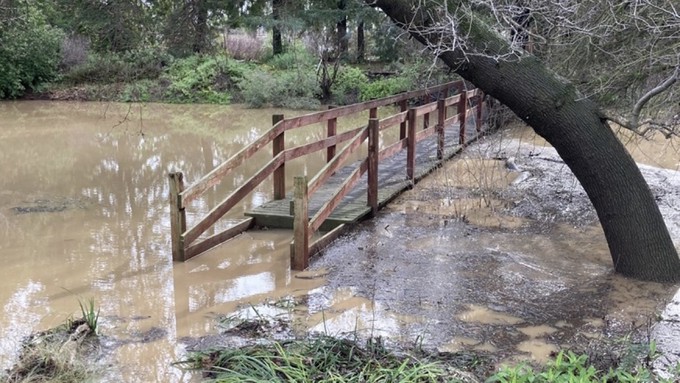
CNPS Garden Ambassador opens property for self-guided tours

This month is a great time to see how a native garden comes alive after the rains -- and floods. The bridges in Patricia Carpenter's garden were completely covered with water for a while, she says. Photo courtesy Patricia Carpenter
There is life in the garden in winter! And native plants are especially interesting, as anyone visiting Patricia Carpenter’s Yolo County garden on Sunday, Jan. 29, will be able to discover.
Carpenter, a California Native Plant Society Garden Ambassador, opens her property that day for her Seasonal Winter Ramble. Described as a “1-acre wild escape on the slough,” the garden is located west of Davis. Expect to see winter growth, wildlife, birds, fungi and emerging wildflowers, as well as the form and color of trees without their leaves.
The garden, west of Pierce Ranch Road south of Russell Boulevard, will be open from 11 a.m. to 3 p.m., rain or shine, for self-guided tours; start any time during those hours. Maps will be available for use on site. Admission is free but registration is required; find the form here. Specific directions to the site will be available to registrants.
Carpenter herself will offer an optional short orientation and Q&A session at noon, repeated at 2 p.m. (Meet near the check-in table.) She began planting the site in 2005, and it now features about 400 varieties of California natives. Visit her Garden Ambassador profile on the CNPS website to read more about the garden, including a plant list. Carpenter’s non-native garden also will be open to view Jan. 29, and the Miridae Mobile Plant Nursery will be on site for sales during the event.
Visitors to the garden are advised to wear sturdy shoes; bringing a lunch or snack is welcome. A composting toilet is available. Masks are optional. Please do not bring dogs.
Questions? Email both Carpenter, pcarpenter.flower@gmail.com, and Maya Argaman, margaman@cnps.org with "Garden Ramble" in the subject line.
Comments
0 comments have been posted.Sacramento Digs Gardening to your inbox.
Sites We Like
Garden Checklist for week of July 21
Your garden needs you!
* Keep your vegetable garden watered, mulched and weeded. Water before 8 a.m. to reduce the chance of fungal infection and to conserve moisture.
* Feed vegetable plants bone meal, rock phosphate or other fertilizers high in phosphate to stimulate more blooms and fruiting. (But wait until daily high temperatures drop out of the 100s.)
* Don’t let tomatoes wilt or dry out completely. Give tomatoes a deep watering two to three times a week.
* Harvest vegetables promptly to encourage plants to produce more. Squash especially tends to grow rapidly in hot weather. Keep an eye on zucchini.
* Pinch back chrysanthemums for bushy plants and more flowers in September.
* Remove spent flowers from roses, daylilies and other bloomers as they finish flowering.
* Pinch off blooms from basil so the plant will grow more leaves.
* Cut back lavender after flowering to promote a second bloom.
* It's not too late to add a splash of color. Plant petunias, snapdragons, zinnias and marigolds.
* From seed, plant corn, pumpkins, radishes, winter squash and sunflowers.